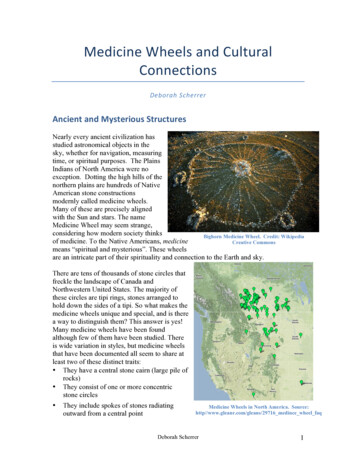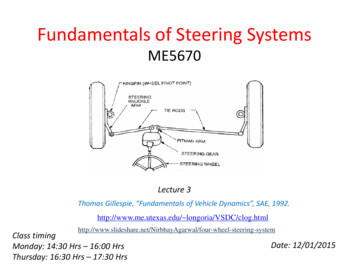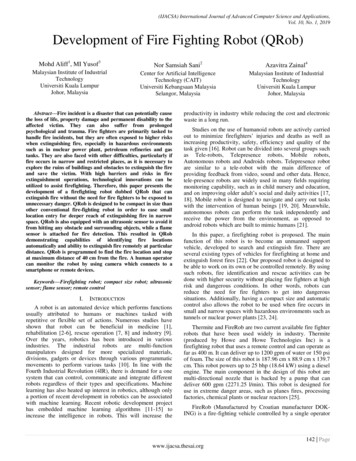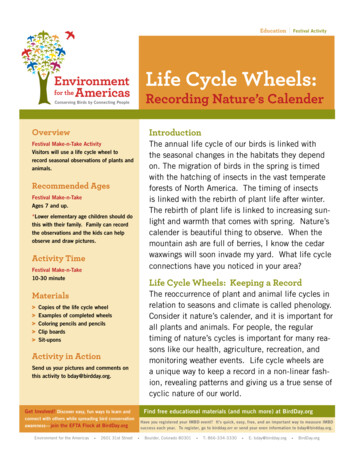
Transcription
rAncientandMysteriousStructuresNearly every ancient civilization hasstudied astronomical objects in thesky, whether for navigation, measuringtime, or spiritual purposes. The PlainsIndians of North America were noexception. Dotting the high hills of thenorthern plains are hundreds of NativeAmerican stone constructionsmodernly called medicine wheels.Many of these are precisely alignedwith the Sun and stars. The nameMedicine Wheel may seem strange,considering how modern society thinksBighorn Medicine Wheel. Credit: Wikipediaof medicine. To the Native Americans, medicineCreative Commonsmeans “spiritual and mysterious”. These wheelsare an intricate part of their spirituality and connection to the Earth and sky.There are tens of thousands of stone circles thatfreckle the landscape of Canada andNorthwestern United States. The majority ofthese circles are tipi rings, stones arranged tohold down the sides of a tipi. So what makes themedicine wheels unique and special, and is therea way to distinguish them? This answer is yes!Many medicine wheels have been foundalthough few of them have been studied. Thereis wide variation in styles, but medicine wheelsthat have been documented all seem to share atleast two of these distinct traits: They have a central stone cairn (large pile ofrocks) They consist of one or more concentricstone circles They include spokes of stones radiatingoutward from a central pointMedicine Wheels in North America. Source:http//www.gleanr.com/gleans/29716 medince wheel faqDeborah Scherrer1
They have markers that could indicate alignmentsAlthough all medicine wheels typically share some of these traits, they can be verydifferent from one another in overall design. There are different types of wheels withdifferent styles of construction. Some look like wagon wheels, some look like bull's-eyes,and others are more abstract. There are only a few hundred large medicine wheels left.They are fragile sites, most protected only by keeping their exact locations secret.WhobuilttheGreatMedicineWheels,andWhen?The Medicine Wheels in North America were built by the ancient Plains Indians,nomadic tribes including the Sioux (Lakota, Dakota, Nakota), Cheyenne, Crow,Blackfoot, Arapaho, Cree, Shoshoni, Comanche, and Pawnee. Because these tribesfollowed herds of buffalo and deer, they were typically on the move most of the year. Atone time the Plains Indians occupied all of central North America, from the NorthSaskatchewan River in Canada, to Texas, and from the valleys of the Mississippi and theMissouri to the foot of the Rockies.Since they rarely stayed in one place, thesenomads did not need to build permanentstructures out of stone. Thus architecturalevidence of the ancient plains Indians isalmost non-existent. Along with the lackof permanent buildings, they did not havea written language. Their knowledge andlore were passed down in folklore -stories told through generations.Even though they left no books to guideus, much of their story can be gleaned inPlains Indians teepees. Source:their art and artifacts. Many of s/objects reflect their builder’s fascinationand respect for the Sun and sky. Theylooked at the heavens with wonder and awe just as we continue to do today. It appearsthese ancient Plains Indians were deeply connected to their environment and their storiesand mythology are rich with celestial themes.Medicine Wheels vary in age by centuries. The current Bighorn Medicine Wheel inWyoming is thought to be about 800 years old, thus still fairly "new." However, there issome evidence (Eddy 1974) that the wheel existed for much longer than that, and that thecurrent wheel is only the last instantiation of a wheel at Bighorn. The Moose Mountainwheel in Saskatchewan is thought to be about 2000 years old. Moose Mountain is sosimilar to Bighorn that some believe it was the model for the younger wheel. The oldestwheel known is in Majorville, Canada. Archaeologists have set its age at 5000 years,around the time of the great pyramids of Egypt.Deborah Scherrer2
WhatPurposeDoMedicineWheelsServe?Though there are hundreds of medicine wheels in North America, mostly in Canada, onlya small percentage have been studied. In that small percentage, an interestingcorrespondence has been discovered: most of these wheels have a cairn, or central pile ofstones, and markers surrounding the cairn that could be used to align, or point to, thesunrise at summer solstice.The more elaborate constructs of the Bighorn, Moose Mountain, and the Majorvillemedicine wheels have become the center of the studies of astronomers and archaeologistsalike. What makes these wheels so unique is that they are thought to be aligned to objectsin the sky, especially the Sun, Moon, and certain key stars.SolarandStellarAlignmentsAstronomer John Eddy (Eddy 2074) became intrigued by the cairns (large piles of stones)of the Bighorn Medicine Wheel in the 1970s. He discovered that one pair of cairns wasaligned to solstice sunrise and another to solstice sunset. But he could find no answer forthe existence of the other cairns. They seemed to have a purpose since they were soprominent. What could it be?Bighorn Medicine Wheel at Summer Solstice Sunset. Note the alignment.Credit: Tom Melham. Used with permission.Dr. Eddy began his search with the sunrises and sunsets of other important dates, such aswinter solstice and the equinoxes but found no correlations. Not easily deterred, hechecked for alignments to the Moon and stars. The paths and cycles of the Moon lead tonothing substantial. However, in the stars he found an intriguing correlation. Because ofthe Bighorn wheel's location, on top of a high and windy mountain, the wheel is onlyDeborah Scherrer3
accessible for about two months in mid summer. The rest of the year the wind-sweptplateau is covered in snow and freezing cold. Eddy needed a starting point so he beganlooking for stars that were in the sky in the months before and after summer solstice,when the mountain was accessible.What he found were alignments to three stars during their heliacal risings. Heliacal(dawn) risings occur when a star has been behind the Sun for a season, but is justreturning to visibility (more on this later). There is one morning when the star "blinks" onbefore the sunrise, after not having been seen for months. That one special morning iscalled the star's heliacal rising. Not all stars have heliacal risings because some starsremain above the horizon all the time. Only certain stars rise and flash into existence inthe predawn glow of the horizon. Each day that passes after the heliacal rising, the starwill appear to rise earlier and remain in the sky longer until its soft glow is obliterated bythe rising Sun. Because these helical risings were so specific, just one day per year, theywere used by many different ancient civilizations to mark specific events such as thedrought season and planting time. It is not surprising that the Plains Indians would useheliacal risings to signal the coming and going of the solstice.Eddy found that three major cairn-pairs had corresponding heliacal rising alignments toAldeberan, Rigel, and Sirius, three of the brightest stars in the sky. A later researcherfound a cairn alignment for Fomalhaut, another very bright star. These alignments alloccur from standing and sighting at one specific cairn.The heliacal rising of Aldeberan signals the coming of the summer solstice in just acouple days. Rigel rises almost exactly one lunar month (28 days) after Aldeberan andSirius one month after Rigel. This could account for Bighorn's 28 spokes. The rising ofSirius could be the signal to pack up and leave Bighorn because the weather was going totake a severe turn. The alignment of Fomalhaut occurs 28 days before the solstice.Perhaps serving as a warning that solstice is near.Deborah Scherrer4
TheBighornMedicineWheelinWyomingLocation: in the MedicineWheel/Medicine Mountain NationalHistoric Landmark in BighornNational Forest, WyomingLatitude 44 49.6'Longitude 107 55.7'Date Constructed: 1200-1700 CEElevation: 9,642 feet.On top of the Bighorn Range inWyoming, a desolate 9,642 feet highand only reachable during the warmsummer months, lies an ancient NativeBighorn Medicine Wheel. Credit: photograph by Richard Collier,American construction -- an 80'Wyoming State Historic Preservation Office. Used with permission.diameter wheel-like pattern made ofstones. At the center of the circle is a doughnut-shaped pile of stones, a cairn, connectedto the rim by 28 spoke-like lines of stones. Six more stone cairns are arranged around thecircle, most large enough to hold a sitting human. The central cairn is about 12 feet indiameter and 2’ high.If you stand or sit at one cairn looking towards another, you will be pointed to certainplaces on the distant horizon. These points indicate where the Sun rises or sets on thesummer solstice and where certain important stars rise heliacally, that is, first rise at dawnafter being behind the Sun. The dawn stars helped foretell when the Sun ceremonial dayswould be coming. The area is free of snow only for 2 months -- around the summersolstice.The wheel has 28 spokes, the same number used in the roofs of ceremonial buildingssuch as the Lakota Sundancelodge. These always include anentrance to the east, facing therising Sun, and include 28 raftersfor the 28 days in the lunar cycle.The number 28 is sacred to someof the Indian tribes because of itssignificance as the lunar month.In Bighorn's case, could thespecial number 28 also refer tothe heliacal or dawn rising ofRigel 28 days past the Solstice,and Sirius another 28 past that?(More below.)Bighorn Cairn. Credit: Deborah ScherrerDeborah Scherrer5
ConstructionThe wheel was constructed by Plains Indians around 800 years ago and has been usedand maintained by various groups since then. There is some evidence that the wheelmight be much older, with only the most recent version visible. The central cairn is theoldest part, with excavations showing it extends below the wheel and has been buried bywind-blown dust. It may have supported a central pole. The star alignments are mostaccurate for around 1200 AD, since slight changes in the Earth's orbit have causedperturbations since. The solstice alignments remain accurate today. However, there isevidence that other wheels have been adjusted to keep up with the centuries.The Bighorn wheel is part of a much larger complex of interrelated archeological sitesthat represent 7000 years of Native American adaptation to and use of the alpinelandscape that surrounds Medicine Mountain. Numerous contemporary American Indiantraditional uses include ceremonial staging areas, medicinal and ceremonial plantgathering areas, sweat lodge sites, altars offering locales and fasting (vision quest)enclosures. Examples ofthese can be foundnearby. Ethnohistoric,ethnographic, andarcheological evidencedemonstrates that theMedicine Wheel and thesurrounding landscapeconstitute one of the mostimportant and wellpreserved ancient NativeAmerican sacred sitecomplexes in NorthAmerica. Prayer offeringsare left even today.Modern prayer flags. Credit: Deborah ScherrerAstronomical AlignmentsIn 1974, an archaeoastronomer named Jack Eddy visited this Medicine Wheel andstudied its alignments, that is, its arrangements of rocks, cairns, and spokes. He found thearrangements point to the rising and setting places of the Sun at summer solstice, as wellas the rising places of Aldebaran in Taurus, Rigel in Orion, and Sirius in Canis Major -all bright, important stars associated with the Summer Solstice. Later another astronomer,Jack Robinson, found a cairn pair that marked the bright star Fomalhaut's rising pointwith the Sun 28 days before the summer solstice.Deborah Scherrer6
Sighting from cairn E through the centerhub (which may have supported a pole)marks the summer solstice sunrise.Sighting from C through the centermarked the equivalent solstice sunset.Note the perfect alignment and reflectionoff the spokes.Standing at cairn F, one could sight theonce-yearly dawn, heliacal, risings of thekey stars Aldebaran, Rigel, and Sirius,which play symbolic roles in an ancientCheyenne Massaum ceremony and arealso important stars in the sacred Lakotacircle constellation "The Animal".The dawn or heliacal rising of a star isDiagram of Big Horn Alignments. Credit: Jack Eddyimportant because it pinpoints a dateexactly. This is the day a star is first seen, just before dawn, after it has been behind theSun for an entire season. From about 1200 AD to 1700 AD, these 4 stars would haveacted as solstice markers for the Native Americans - Fomalhaut (F to D) would rise 28days before the Summer Solstice, Aldebaran (F to A) would rise during the 2 days justbefore the solstice, Rigel (F to B) would rise 28 days after the solstice, and Sirius (F to C)28 days after that, at the end of August and hence marking the end of summer and time toleave the mountain.Summer solstice sunrise at Big Horn, showing alignment with the medicine wheel rocks.Image courtesy Tom Melham.Deborah Scherrer7
Some researchers believe that Bighorn closely resembles a Medicine Lodge or SunLodge. These structures were built out of wood by the Plains Indians for their sacredSundance ceremony. This supposition is supported by the lack of timber in the areawhere Bighorn was built. Stone would have been a more abundant building material thanwood. However, this correspondence does not fit with all medicine wheels since Bighornis one of the few that resemble the shape of the lodge.The heliacal alignments on the Bighorn wheel could be as simple as signifying the timesof year when the weather is suitable for being on the mountain. The rising of Siriuswould have been the signal to pack up and leave before the winter weather set in.We do know that wheels had many different uses and those uses changed over the yearsfrom tribe to tribe. Some of them were used as burial mounds, or created to mark aspecial day in history. Some of them point not only to the Sun but other medicine wheelsor natural resources. There seems to be evidence that some of the wheels were updatedover the centuries to track the slight changes in solar and stellar alignments.The Bighorn Medicine Wheel remains a part of Native American ritual life even today.Online Tours of Bighorn1. For an online tour of the Big Horn medicine wheel, seeMedicine Wheel Virtual )2. For a 3-D tour of the Medicine Wheel:mov format mpg format wmv format3. For a better understanding of the Sun rising/setting at Medicine Wheel, ml4. For a video of the heliacal (dawn) risings of stars, .htmlSee also: Eddy, John A, "Astronomical Alignments of the Bighorn Medicine Wheel,"Science 184(4141):1035-1043; 1974. Map and views of the wheel and dicine-wheel The Turtle and the Serpent – Phases of a Medicine story/phases Young, Judith S., Moon Teachings for the Massess at the UMass Sunwheel andAround the World. tmlDeborah Scherrer8
Majorville–theOldestMedicineWheelLocation: Vulcan County, Alberta, CanadaWhen Constructed: 4,500 BPLatitude: 50.585167NLongitude: 112.410639WAerial photo of the Majorville Medicine Wheel, with the 28 spokes highlighted in black. From GordonFreeman - wheels-of-north-americaConstructionThe Majorville Medicine Wheel, the largest and oldest extant medicine wheel, consists ofa central cairn that is linked to a surrounding stone circle by 28 spokes. The medicinewheel is part of an extensive cultural landscape encompassing 160 acres and situated on aheight of land with an expansive view of the surrounding prairie landscape west of theBow River in southern Alberta. The central cairn is nine meters in diameter and issurrounded by a stone circle 27 meters across. About 28 spokes link the circle and centralcairn. In 1971 an excavation yielded artifacts that were dated by stone tool style. Thismethod and radiocarbon dating of bone place initial construction of the central cairn atsome 4500 BP, although another source dates the initial site to 3200 BP. The tool findsindicate a succession of added material over the centuries. Archaeological studiesindicate this site has been continuously used for the last 4,500 years, making this one ofthe oldest sacred sites in the world.Deborah Scherrer9
AlignmentsProfessor Gordon Freeman of Saskatchewan, an Oxford- and University ofSaskatchewan- and McGill-trained scholar and Professor Emeritus at the University ofAlberta studied Majorville from 1989 to 2006. Freeman found striking similaritiesbetween the surface geometry of Stonehenge and the stone patterns at Majorville. Heconcludes that Majorville stones are really the remains of an open-air Sun temple thatpredates both Stonehenge in England and the Pyramids in Egypt. According to Freeman,the Plains Indians used the temple to observe sunrise on the winter and summersolstices.According to the Canadian Archaeological Association, “Majorville has associated withit outlying rock lines and cairns that accurately mark the Sun rise and set points on thesolstices and on the equinoxes. The point of the Sun's first flash on the horizon is the riseposition, and the point of the last flash on the horizon is the set position. These pointsmove northward from December to June, then move southward again after the summersolstice. Near an equinox the Sun rise and set points at Majorville move along the horizonby 1.3 Sun diameters per day. Near a solstice it takes nine days to move the last diameterto the solstice position.“We determine the Sun rise and set points photographically to within less than one Sun'sdiameter, and sometimes to within a fifth of a diameter, along alignments up to 2km long.“Rock alignments at Majorville mark the Sun rise and set points three days before thevernal equinox and three days after the autumnal equinox. “These days are within twominutes of being exactly 12 hours long. The lens effect of the atmosphere causes thelength of the solar equinoctial days to be about 12 hours and 10 minutes long atMajorville. The position of sunrise on the 12.00 hour day is marked by a spoke in theMedicine Wheel, which points to a large white limestone in the East House 61m away,and to a configured part of the eroded river bank 1100m away. Rocks have slid down theeroded bank from the sightline position. The Sun rises over the horizon about 30kmdistant.“A more spectacular 12.00 hour day sunrise marker involves two V sights of rocksseparated by 70m, on the west side of the Medicine Wheel hill. The sighting line istangent to the Wheel. Because one is looking up the shaded side of the hill, the Sunbecomes visible in the nested bottoms of the V's a half hour after the first flash on thedistant horizon. Thus, one can observe the equinox sunrise even if the distant horizon isovercast to a depth of several sun diameters. The 12.00 hour day sunset is marked by aspoke of the Wheel which points to a small cairn on a hillock 1100m away and to a rippleon the horizon about 10km distant. The important part of the Majorville Medicine Wheelsite covers 13km. It is 20,000 times larger than previously thought.” (Freeman 2009)Deborah Scherrer10
See also: Freeman, Gordon R. (2009), Canada’s Stonehenge – Astounding ArchaeologicalDiscoveries in Canada, England, and Wales, Kingsley Publishing, 2009. Freeman, Gordon R. (2012), “Hidden Stonehenge: Ancient Temple in NorthAmerica Reveals the Key to Ancient Wonders, Watkins, 2012. Freeman, Gordon R. (1992), Majorville Medicine Wheel Complex: DistantOutliers and Accurate Solstice Alignments. Canadian ArchaeologicalAssociation. s-and-accurate-solstice-alignments Freeman, Gordon R. (1991). Majorville Medicine Wheel Complex: Marking the12.00 hour day, not the true solar equinox. Canadian Archaeological 200-hour-day-not-true-solar-equinox Freeman, Gordon R. (2001) Multiple Observation Lines for the summer solsticesun rise in the Majorville medicine wheel complex. Canadian ArchaeologicalAssoc. majorville-medicine-wheel-complex http://www.megalithic.co.uk/article.php?sid 22751 wheels-of-north-americaView from the ground towards the central cairn. Credit: Gordon FreemanDeborah Scherrer11
One of the most exciting connections tothe wheels is the Plains Indian SunDance (Scherrer 2005 Sun Dance). Formany of the Plains Indians, including theLakota, the Sundance (Sundancecrystallinks) or Wiwanyag Wachipi(Brown) was their major communalreligious ceremony. Generally held inthe late spring or early summer, the ritecelebrates renewal, spiritual rebirth, andregeneration of the living Earth with all1886 engraving showing Cree Indians performing a Sundance.its components. The ritual involvesSource: ring at the Sun while dancing,personal sacrifice, and supplication toinsure harmony between all living things. There is a symbolic role played by animals inthe Sundance as well. Contemporary Native Americans continue the Sundance today(The Sun Dance sacred texts).See also: The sundance of the Blackfoot Indians, an historical monograph about theBlackfoot Indian’s Sun Dance (Clark 1918).OralTraditionsandtheMedicineWheelsNative Americans relied almost solely on oral traditions to pass along importantknowledge through the generations. Very littleis known about the origins of the MedicineWheels because much of the history and theseoral traditions have been lost. Some say thatmedicine wheels were a guide from the heavenson how to build the first tipis. Other legendsnote that they were built "before the lightcame." One Crow story speaks of a man namedScarface: "Scarface was handsome and wasfond of strutting in his finery before youngwomen. One day while entering his mother'stipi, he fell into the fire that severely burned hisface. He was thereafter embarrassed to be seen.Shamed at his appearance, he left his people andwent to live in the mountains. Scarface livedNative American storytellers. Credit: Nativealone for many years. One day while a youngLiterature – Oral History.woman and her grandmother were hunting berries,Deborah Scherrer12
they became separated from their people and couldn't find their way back. They traveledalong a trail that took them into the mountains. They occasionally saw Scarface and oneday made contact with him. Scarface later married the young woman. On their travelsback to his people, Scarface supposedly built the Medicine Wheel as their shelter. On thesecond day, he built another tipi by the Bighorn River in the valley below. The tipi ringsare believed to still exist." Tale from Bighorn Medicine WheelMany claim that the Medicine Wheels symbolize all creation, all peoples and all animals.It's circular shape echoes the cycles of the Earth, Sun, seasons, and life. For more onNative American spirituality, see Native American Myths.There are other sites as well that show the veneration Native Americans held for the Sun,the Earth, and their sacred connections.SacredChacoCanyonAncient peoples in the Chaco Canyon area of New Mexico designed their massivespiritual center with solar alignments and markers playing dramatic and visual roles. Theimage at right shows the Sundagger, a shaft of light bisecting a carved spiral at noon onthe Winter Solstice. For more information about Chaco, visit Chaco Canyon by theExploratorium and Traditions of the Sun, a NASA visual exploration of Chaco.Sunrise at Chaco Canyon. Credit: Deborah ScherrerChaco Canyon Sundagger.Courtesy Anna Sofaer.Deborah Scherrer13
NativeViewsfromSpace"Through traditional customs and symbols like the medicine wheel, a circulararrangement of stones often interpreted as representing the relationship between Earth,air, water and fire, Native Americans have longrecognized and celebrated the connectednessamong all natural things. Indeed, the NativeAmerican view of the world has always beenconsistent with that of Earth system science -- thatEarth is a single system of interconnected parts."NASA's Native Views from Space site exploresinteractions between Earth's various components,including the Medicine Wheel, in a new light.The image, from NASA’s Landsat 7 satellitehelped support damage assessment after a fire onLandsat 7 image of a fire on the Sioux tribalthe lands of South Dakota’s Sioux Tribe.land. Credit: USGSSimilarAlignmentsatCahokia"Woodhenge"When the equinoxes arrived in the ancient city of Cahokia, near present-day St. Louis,priests watched the sunrise from inside a ring of cedar poles that served as a calendarvery similar to the Medicine Wheels. Built by the Mississippian culture, the city ofCahokia arose around 700 AD and forhundreds of years served as the center of ahuge trading network linked to other societiesof North America. Cahokia was one of themost advanced civilizations in ancientAmerica. It reached its zenith around 11001200 AD, when its population swelled to asmuch as 20,000.Cahokian inhabitants built a series of largecalendrical circles ringed with wooden poles.These may have served a similar function tothe Medicine Wheels. Instead of stone,Cohokia Woodhenge. Credit: Wiki commonsCahokians used red cedar posts 15 to 20 inches indiameter and about 20 feet long. Each circleconsisted of a central Sun-watching station, surrounded by a ring of cedar poles.Watching from the center, a priest would see the Sun aligned with the poles on thesolstices, equinoxes, and other important solar dates. Archaeologists have named thesecircles Woodhenges because of their resemblance to England's Stonehenge.Cahokians eventually faced a series of problems driven by overpopulation, poorenvironmental practices (including cutting down all their trees), and a change in climate.By 1400, the city was abandoned.Deborah Scherrer14
Archaeologists have rebuilt one of the Woodhenge circles, that you can see at CahokiaMounds State Historic Site. Learn more about Cahokia at Ancient Cahokia (a site by theWashington The Lakota Sioux call the Sun "Wiyo ate" and say "The light of the Sun enlightens theentire universe, and as the flames of the Sun come to us in the morning, so comes thegrace of Wakan Tanka, by which all creatures are enlightened. It is because of this thatthe four-leggeds and the wingeds always rejoice at the coming of the light. We can all seein the day, and this seeing is sacred for it represents the sight of that real world which wemay have through the eye of the heart." Black ElkTo these same people, the stars (Wichahpi) are wakan -- holy, sacred, powerful, andmysterious. "Sometimes they come to the world and sometimes the Lakotas go to them.There is one star for the evening and one for the morning. One star never moves [theNorth Star]; other stars move in a circle about it. They are dancing in the dance circle.There are seven stars. This is why there are seven council fires among the Lakotas. TheSpirit Way is among the stars. It begins at the edge of the world. No man can find it.Wakan Tanka keeps the bad spirits away from the Spirit Way." Ringing ShieldSeealso: Cahokia Mounds State Historic Site. https://cahokiamounds.org/Crystalinks Bighorn Medicine Wheel http://www.crystalinks.com/bighorn.htmlCrystalinks Sun Dance http://www.crystalinks.com/sundance.htmlDeborah Scherrer15
Exploratorium Ancient Observatories - Chaco Canyon.http://www.exploratorium.edu/chaco/Lakota Rites – Wiwanyag Wachipi (The Sun tmlLakota Symbolism. he Stars (Wichahpi) Lakota gs2.html#starsLiving Myths Native American Mythshttp://www.livingmyths.com/Native.htmNASA Traditions of the Sun http://www.traditionsofthesun.org/NASA (2003) Native Views from rth/F Native Views Space.htmlNative Literature – Oral History. http://nativeliterature.org/Sacred Texts The Sun .htmSeppa, Nathan (1997). Metropolitan Life on the Mississippi. Ancient Cahokia.The Washington /daily/march/12/cahokia.htmThe Sun (Wiyo ate). Lakota gs2.html#sunWakan Tanka. Lakota ept2.html#tankaPossible solar eclipse petroglyph at Chaco Canyon. Courtesy Deborah Scherrer.Deborah Scherrer16
MedicineWheelModelStudents learn much by designing and developing models. Here, Shannon Lee. Agraduate student in astrophysics, made a simple model of the Bighorn Medicine Wheel.She used foam board, pebbles, and string to model the stellar and solar alignments. Sheworked from Dr. Jack Eddy's diagram as well as a visit to the actual site.ASimpleChalk- ‐and- ‐StringWheelThe Chabot Space and Science Center in Oakland, California has designed an activity tobuild your own simple Medicine Wheel on your schoolyard, using only string and chalk.Of course, you could always add rocks! See Sunwatchers of the Southwest ttp://w
Medicine Wheels vary in age by centuries. The current Bighorn Medicine Wheel in Wyoming is thought to be about 800 years old, thus still fairly "new." However, there is some evidence (Eddy 1974) that the wheel existed for much longer than that, and that the current wheel is only the last instantiation of a wheel at Bighorn. The Moose Mountain










